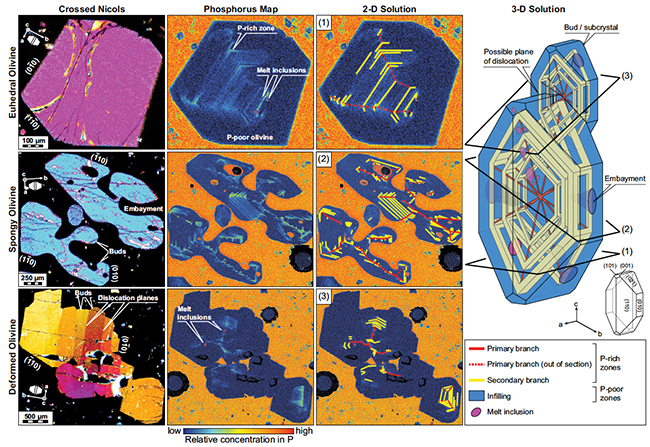Current Projects in Crystal Growth
Do many euhedral phenocrysts start out as dendrites?
Welsch et al. evaluate X-ray maps of crystallographically oriented crystals in ankaramite samples from Haleakala (Maui), and combine these 2D view of the crystals with observations of 3D external morphologies to consider the time-evolution of crystal growth conditions. Although not evident from BSE or polarized light microscopy, the most plausible explanation for the observed spatial heterogeneity of Si, Mg, Al, and Ti is sector zoning. This has implications for applying cpx-liquid thermobarometry to these samples. Viewed in the context of experimental data (Kouchi et al., 1983), the compositional complexity afforded by sector zoning in clinopyroxene provides additional insights to magmatic processes in deep-seated reservoirs.
Welsch, B., Hammer, J., Baronnet, A., Jacob, S., Hellebrand, E., and Sinton, J. (2016) Clinopyroxene in postshield Haleakala ankaramite: 2. Texture, compositional zoning and supersaturation in the magma. Contrib. Mineral. Petrol. 171, 6, DOI 10.1007/s00410-015-1213-9. Supplement1. Supplement2.
Hammer, J., Jacob, S., Welsch, B., Hellebrand, E., and Sinton, J. (2016) Clinopyroxene in postshield Haleakala ankaramite: 1. Efficacy of thermobarometry. Contrib. Mineral. Petrol. 171, 7, DOI 10.1007/s00410-015-1212-x. Supplement1. Supplement2. Supplement3. Supplement4. Supplement5. Supplement6. Supplement7.
Funding: NSF EAR12-20084
Welsch et al. perform a microanalytical study of a diverse suite of volcanic and intrusive rocks from Earth and the moon, and challenge a fundamental assumption about crystal growth in igneous environments— that growth proceeds in “tree-ring” fashion. Rather,a skeletal or even dendrite architecture may result from early diffusion-controlled growth. This explanation unifies varied but ubiquitous features of igneous olivine.
Welsch, BT, Hammer, JE and Hellebrand, E. (2014) Phosphorus zoning reveals dendritic architecture of olivine. Geology doi: 10.1130/G35691.1.
Funding: NSF EAR12-20084
Does superheating play a role in driving diffusion-limited (rapid) initial growth? If so, how?
Leonhardi et al (2015) explore the role of delayed nucleation caused by magma superheating (cooling from above the liquidus) in driving rapid, diffusion controlled initial growth. An olivine melilite liquid is prepared by heating at various temperatures at and above the olivine-in temperature at 1-atmosphere, and subsequently cooled at constant rate. Leonhardi et al. observe higher incidence of anhedral morphologies associated with the magnitude and duration of superheating. Superheating of rejuvenation-stage ocean island magmas may be caused by rapid (adiabatic) ascent from mantle depths.
Leonhardi, TC, Hammer, JE, and First, EC (2015) Effect of Superheating on Olivine Nucleation and Growth in a Silica-Undersaturated Melt: An Experimental Study. AGU Fall Meeting V41B-3071
Funding: NSF EAR12-20084
[ top of this page | return to Research page | go to Experimental Studies of Martian Basalt]




